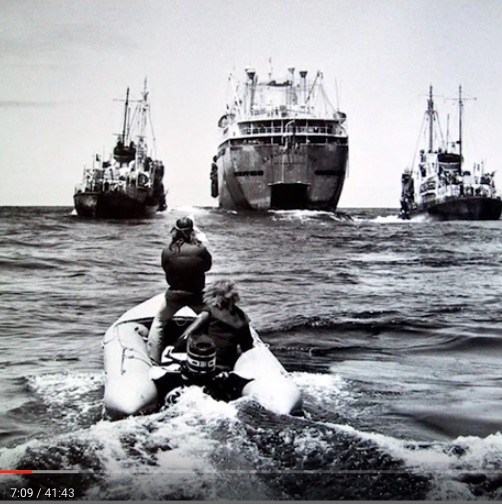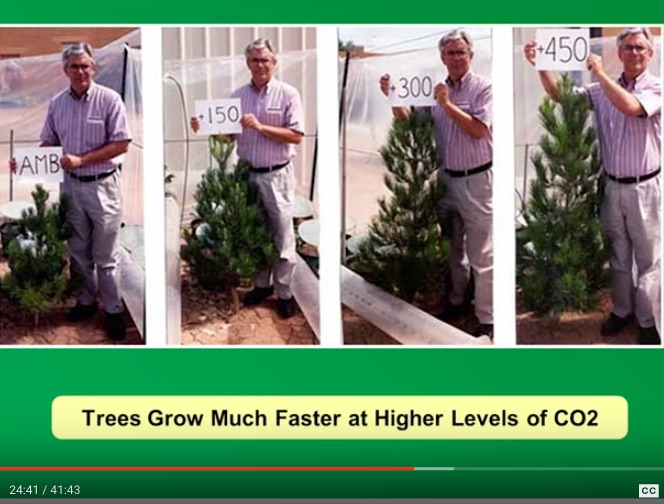
A founder and long insider at Greenpeace gives us a fascinating 45 minute lecture with a 15 page transcript.For your pleasure I savagely cut the 15 page transcript back to 2.5 pages of paper (or 80% of one big page on an iMac screen). This is it. Enjoy!
PhD in ecology in 1971,
Patrick Moore becomes a radical environmental activist.
Fifteen years in the lead group in Greenpeace opposing US underground nuclear weapons testing,
French atmospheric nuclear testing,
whaling,
and clubbing baby seals.
His video shows from international media this picture of him running a small inflatable boat into the Soviet whaling fleet.
Greenpeace created a focal point for the media to report on public opposition to nuclear tests
and to stopping killing whales.
They were successful.
Good for them!

But, he was the only director of Greenpeace with a formal education in science. He left it because they drifted into a belief that humans are the enemies of the earth. Set himself to develop an environmental policy that is based on science and logic rather than sensationalism, misinformation, anti-humanism and fear. For example, he favors genetically modified (GMO) Golden Rice solving the vitamin A deficiency in Africa.
He reminds us that NASA and many scientists benefit from the fear of Climate Change.
He accepts that most of the rise of CO2 from 280 to 400 ppm is caused by human CO2 emissions.
The G7 plan to "end extreme poverty and hunger" by phasing out 85% of the world's energy supply including 98% of the energy used to transport people and goods, including food. Ridiculous, he implies.
Because of volcanism, CO2 was many times higher for the first 4 billion years of Earth's history than it has been since the Cambrian Period (450 M years ago) until today. After the Cambrian he says temperature and CO2 are in an inverse correlation as often as not.
In the Devonian Period (400 million years back) beginning plants evolved to produce lignin, which in combination with cellulose, created wood which in turn for the first time allowed plants to grow tall for sunlight. Forests pulled down carbon as CO2 from the atmosphere to make wood. Lignin is very difficult to break down and no decomposer species possessed the enzymes to digest it. Trees died atop one another until they were 100 metres or more in depth. This was the making of the great coal beds around the world as this huge store of sequestered carbon continued to build for 90 million years. Then, fortunately for the future of life, white rot fungi evolved to produce the enzymes that can digest lignin and so the coal-making era came to an end. If it had not, CO2, which had already been drawn down for the first time in Earth's history to levels similar to today's, would have continued to decline until CO2 approached the threshold of 150 ppm below which plants begin first to starve, then stop growing altogether, and then die. Not just woody plants but all plants. This would bring about the extinction of most, if not all, terrestrial species, as animals, insects, and other invertebrates starved for lack of food. And that would be that. The human species would never have existed. This was merely the first time that there was a distinct possibility that life would come close to extinguishing itself due to a shortage of CO2.
A well-documented record of global temperature shows that we have been in a major cooling period since the Eocene 50 million years ago. The Earth was an average 16C warmer then. Antarctica was ice free and covered in forest. The ancestors of every species on Earth today survived through what may have been the warmest time in the history of life. But today we hear predictions of disaster with a 2C rise! Glaciers began to form in Antarctica 30 million years ago and in the northern hemisphere 3 million years ago. Today, even in this interglacial period of the Pleistocene Ice Age, we are experiencing one of the coldest climates in Earth history.
From Antarctic ice cores for the past 800,000 years there have been glacial cycles in 100,000 year-cycles coinciding with with the Milankovitch (eccentricity of the Earth's orbit and its axial tilt). There is a strong correlation between temperature and the level of atmospheric CO2 during these successive glaciations, indicating a possible cause-effect relationship between the two. CO2 lags temperature by an average of 800 years during the most recent 400,000-year period, indicating that temperature is the cause, as the cause never comes after the effect.
It is sobering to consider the magnitude of climate change during the past 20,000 years, since the peak of the last major glaciation. At that time there were 3.3 kilometres of ice on top of what is today the city of Montreal (3 million people). If the Milankovitch cycle continues to prevail, this will happen gradually again during the next 80,000 years. Will our CO2 emissions stave off another glaciation?
Water is by far the most important greenhouse gas, and is the only molecule that is present in the atmosphere in all three states, gas, liquid, and solid. IPCC said this in 2007, "we should recognise that we are dealing with a coupled nonlinear chaotic system, and therefore that the long-term prediction of future climate states is not possible." Now they claim they can predict it!
 Plants, including trees and all our food crops,
are capable of growing much faster at higher levels of CO2 than present in the atmosphere today
[slide (at 24:35) shows greenhouse demonstration].
Even at today's concentration of 400 ppm plants are relatively starved for nutrition.
The optimum level of CO2 for plant growth is about 5 times higher.
CO2 is the giver of life.
We should celebrate CO2 rather than denigrate it as is the fashion today.
Plants, including trees and all our food crops,
are capable of growing much faster at higher levels of CO2 than present in the atmosphere today
[slide (at 24:35) shows greenhouse demonstration].
Even at today's concentration of 400 ppm plants are relatively starved for nutrition.
The optimum level of CO2 for plant growth is about 5 times higher.
CO2 is the giver of life.
We should celebrate CO2 rather than denigrate it as is the fashion today.
Beginning 540 million years ago many marine species of invertebrates evolved the ability to control calcification and to build armour plating to protect their soft bodies. Shellfish such as clams and snails, corals, phytoplankton, and zooplankton began to combine carbon dioxide with calcium and thus to remove carbon from the life cycle as the shells sank into sediments. The white cliffs of Dover are made of their calcium carbonate skeletons. The amount of CO2 in the atmosphere was reduced by about 90% during the last 150 million years. If this trend continues CO2 will inevitably fall to levels that threaten the survival of plants, which require a minimum of 150 ppm to survive. If plants die all the animals, insects, and other invertebrates that depend on plants for their survival will also die.
How long will it be at the present level of CO2 depletion until most or all of life on Earth is threatened with extinction by lack of CO2 in the atmosphere? If humans had not begun to unlock some of the carbon stored as fossil fuels, less than 2 million years from today! Human emissions of carbon dioxide have saved life on Earth from inevitable starvation and extinction due to lack of CO2.
Let us have no hominem arguments about "deniers". I submit that much of society has been collectively misled into believing that global CO2 and temperature are too high when the opposite is true for both.
Even when the fossil fuels have become scarce, we have the quadrillion tons of carbon in carbonaceous rocks, which we can transform into lime and CO2 for the manufacture of cement using solar energy or nuclear energy. The human species has made it possible to prolong the survival of life on Earth for more than 100 million years. We are not the enemy of nature but its salvation!